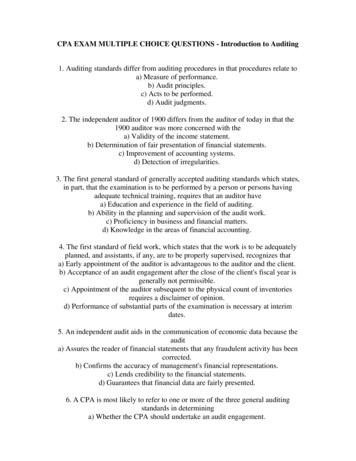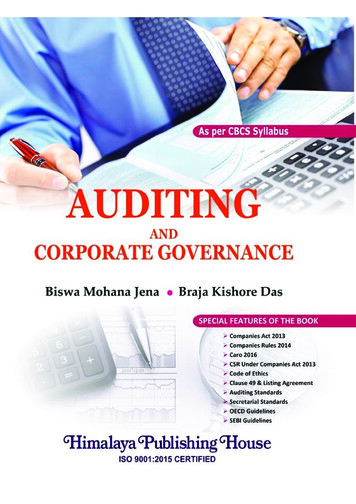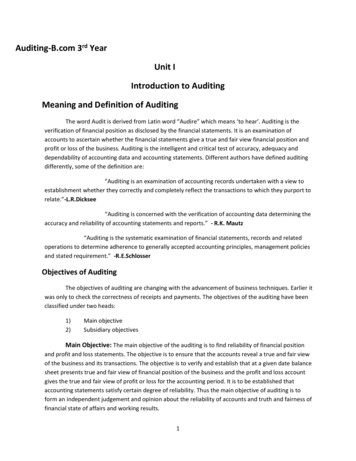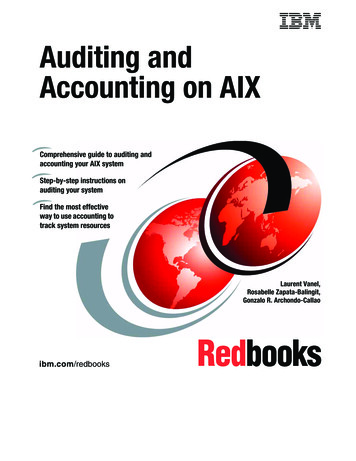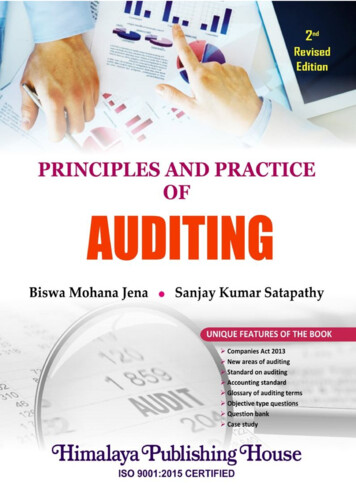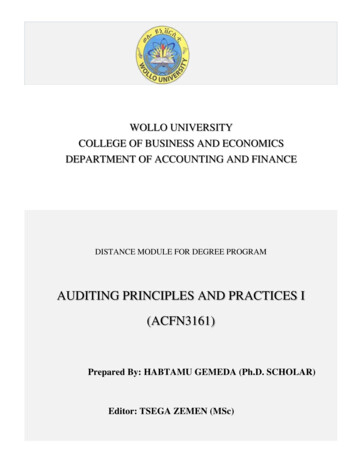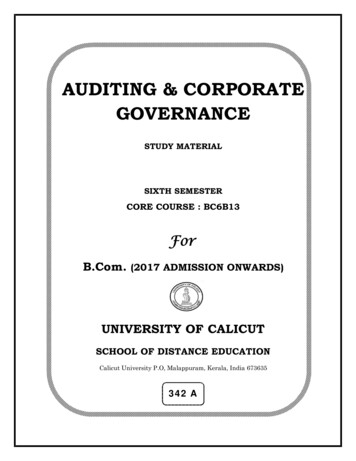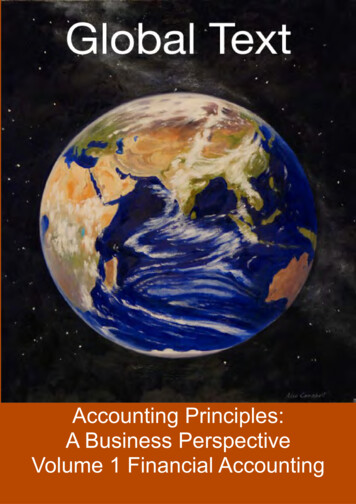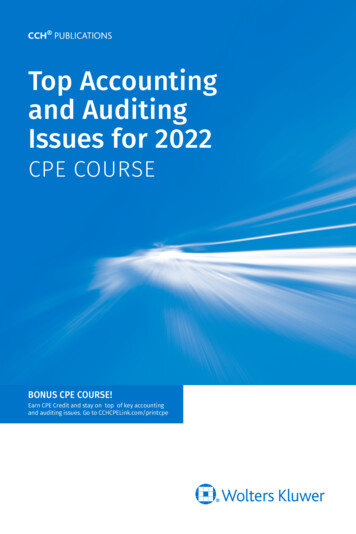
Transcription
Top Accountingand AuditingIssues for 2022CPE COURSEBONUS CPE COURSE!Earn CPE Credit and stay on top of key accountingand auditing issues. Go to CCHCPELink.com/printcpe
Top Accounting andAuditing Issuesfor 2022 CPE CourseSalvatore A. Collemi, CPALynn Fountain, CPA, CGMA, CRMARobert K. Minniti, CPA, CFE, CrFA, CVA, CFF, MAFF, CGMA, PI, DBACecil Patterson, Jr., CPA, MBA
ContributorsContributing Editor . . . . . . . . . . . . . . . . . . . . . . . . . . . . . Salvatore A. Collemi, CPALynn Fountain, CPA, CGMA, CRMARobert K. Minniti CPA, CFE, CrFA, CVA, CFF, MAFF, CGMA, PI, DBACecil Patterson, Jr., CPA, MBAProduction Coordinator . . . . . . . . . . . . . . Mariela de la Torre; Jennifer Schencker;Gokiladevi SashikumarProduction . . . . . . . . . . . . . . . . . . . . . . . . . . Sharon Sofinski; Anbarasu AnbumaniThis publication is designed to provide accurate and authoritative information inregard to the subject matter covered. It is sold with the understanding that thepublisher is not engaged in rendering legal, accounting, or other professionalservice. If legal advice or other expert assistance is required, the services of acompetent professional person should be sought. All views expressed in thispublication are those of the author and not necessarily those of the publisher or anyother person. 2021 CCH Incorporated and its affiliates. All rights reserved.2700 Lake Cook RoadRiverwoods, IL 60015800 344 3734CCHCPELink.comNo claim is made to original government works; however, within this Publication,the following are subject to CCH Incorporated’s copyright: (1) the gathering,compilation, and arrangement of such government materials; (2) the magnetictranslation and digital conversion of data, if applicable; (3) the historical, statutoryand other notes and references; and (4) the commentary and other materials.Do not send returns to the above address. If for any reason you are not satisfiedwith your book purchase, it can easily be returned within 30 days of shipment.Please go to support.cch.com/returns to initiate your return. If you require furtherassistance with your return, please call: (800) 344-3734 M-F, 8 a.m. – 6 p.m. CT.
iiiIntroductionTop Accounting and Auditing Issues for 2022 CPE Course helps CPAs stay abreast of the mostsignificant new accounting and auditing standards and important projects. It does so byidentifying the events of the past year that have developed into hot issues and reviewing theopportunities and pitfalls presented by these changes. The topics reviewed in this coursewere selected because of their impact on financial reporting and because of the role they playin understanding the accounting and auditing landscape in the year ahead.Module 1 of this course reviews top accounting issues.Chapter 1 focuses on the challenges accountants and auditors face due to the COVID-19pandemic. It reviews existing standards in accounting and auditing, and auditing standardsand changes made to be implemented for 2021 and later.Chapter 2 covers new COVID-19 frauds and scams. It examines how criminals are tryingto take advantage of the virus to line their pockets with ill-gotten gains. It outlines information technology (IT) and other frauds as well as cybersecurity in a COVID-19 environment.The chapter also discusses the internal controls businesses should be using to protectthemselves.Chapter 3 Chapter 3 provides an up-to-date overview of some of the most commonaccounting and financial reporting matters in light of the COVID-19 pandemic and resultingeconomic downturn. It focuses on critical accounting technical areas that have been impacted as well as cases where substantial judgment and professional skepticism are necessary to assess the facts and ensure that the operative standards are applied.Module 2 of this course reviews top auditing issues.Chapter 4 discusses Statement on Auditing Standards (SAS) No. 132, The Auditor’sConsideration of an Entity’s Ability to Continue as a Going Concern, from the AICPA’s AuditStandards Board (ASB). SAS No. 132 includes many significant changes in authoritativeprofessional standards concerning going concern issues. It represents changes to theGenerally Accepted Auditing Standards (GAAS) concerning “going concern reporting forentities.Chapter 5 provides external auditors with practical and insightful perspectives on how toaudit transactions under the Financial Accounting Standards Board’s (FASB) new leasingstandard, Accounting Standards Codification (ASC) Topic 842, Leases. It discusses the newaccounting and financial reporting requirements and how to substantively and analyticallytest them in accordance with Professional Standards.Chapter 6 provides external auditors with both practical and insightful perspectives onhow to navigate an audit engagement of a private company during the global pandemic.Readers will learn which areas of the audit have increased in risk exponentially due to theCOVID-19 pandemic and which viable alternative audit procedures are available in circumstances where traditional audit procedures are just not possible. Readers will acquire adeeper understanding of how to fulfill their professional responsibilities in order to performan audit in this challenging environment in accordance with Professional Standards.Chapter 7 reviews recent issues from the AICPA’s Auditing Standards Board (ASB) forprivate entities, including implementation issues with new effective dates. New and revisedaudit standards, attestation standards, and other recent pronouncements about auditing arediscussed. Also, the revised auditing standards resulting from the COVID-19 pandemic areexamined for current application.Study Questions. Throughout the course you will find Study Questions to help you testyour knowledge, and comments that are vital to understanding a particular strategy or idea.
ivAnswers to the Study Questions with feedback on both correct and incorrect responses areprovided in a special section beginning at ¶ 10,100.Final Exam. This course is divided into two Modules. Take your time and review all courseModules. When you feel confident that you thoroughly understand the material, turn to theFinal Exam. Complete one or all three Final Exams for continuing professional educationcredit.Go to cchcpelink.com/printcpe to complete your Final Exam online for immediate results.My Dashboard provides convenient storage for your CPE course Certificates. Furtherinformation is provided in the CPE Final Exam instructions at ¶ 10,300. Please note,manual grading is no longer available for Top Accounting and Auditing Issues. Allanswer sheets must be submitted online for grading and processing.August 2021PLEDGE TO QUALITYThank you for choosing this CCH CPELink product. We will continue to produce highquality products that challenge your intellect and give you the best option for your Continuing Education requirements. Should you have a concern about this or any other WoltersKluwer product, please call our Customer Service Department at 1-800-344-3734.COURSE OBJECTIVESThis course provides an overview of important accounting and auditing developments. At thecompletion of this course, the reader will be able to: Recognize the difficulties of auditing for management and auditors during theCOVID-19 pandemic Describe selected accounting standards (GAAP) and COVID-19 issues from the Financial Accounting Standards Board (FASB) Describe Statements on Auditing Standards (SASs) from the AICPA Auditing Standards Board (ASB) and COVID-19–related issues Recognize changes from the AICPA ASB for 2021 and future years Recognize how criminals are trying to take advantage of the COVID-19 pandemic Identify internal controls companies should be using to protect themselves Describe IT and other frauds as well as cybersecurity in a COVID-19 environment Examine the impact of preparation of current and forward-looking financial statements Identify specific technical accounting and financial reporting areas that may be affectedby conditions of the COVID-19 pandemic Identify emerging topic matters for accounting and financial reporting Recognize actions to take when there are indicators that the fair value of an entity maybe below its carrying amount Outline the process for testing long-lived assets, which includes the use of assumptionsand estimates that may change due to the COVID-19 pandemic Identify an asset that can be traded or seen as packages of capital that may be traded Recognize which Accounting Standards Codification (ASC) Topic provides guidanceon determining when to recognize costs and information that must be disclosed in thenotes to the financial statements Describe conditions evaluated when testing goodwill for impairment in a COVID-19environment
v Identify updates on ASB No. 132 Describe updates on selected AICPA auditing standards Describe updates on selected FASB standards Recognize and apply going concern audit deficiencies Identify updates on selected related and connected issues Differentiate SASs superseded by the new standards Describe correct statements regarding SAS No. 132 Differentiate Accounting Standards Update (ASU) Sections and how they apply Identify a going concern condition or event related to the supply chain Recognize the FASB’s new leasing standard requirements Identify the new accounting and reporting requirements of leases Identify which audit procedures to perform Recognize how to properly audit the transition requirements and initial adoption of thenew standard Recognize the types of transactions that fall within the scope of ASC Topic 842 Identify the first question to be considered when determining whether an arrangementcontains a lease Identify an example of an initial direct cost (IDC) of a lease Identify areas of the audit where risk has gone up significantly due to the COVID-19pandemic Recognize viable alternative audit procedures to perform Describe how to address potential reporting implications Differentiate FASB ASC Topics and how they apply Recognize the specific steps in the order of asset impairment testing Summarize the auditing pronouncements that may impact private companies that comefrom the Auditing Standards Board (ASB) of the AICPA and review other recent auditreleases that affect the non-issuing entities Identify the changes in Statement on Auditing Standards (SAS) Nos. 141, 142, and 143 Recognize changes to attestation in Statement on Standards for Attestation Engagements (SSAE) Nos. 20, 21, and 22 Understand auditing issues and financial reporting considerations related to theCOVID-19 pandemicAdditional copies of this course may be downloaded from cchcpelink.com/printcpe.Printed copies of the course are available for 6.50 by calling 1-800-344-3734 (ask for product10024493-0009).
viiContentsMODULE 1: TOP ACCOUNTING ISSUES1 Accounting, Auditing, and COVID-19Welcome . . . . . . . . . . . . . . . . . . . . . . . . . . . . . . . . . . . . . . .Learning Objectives . . . . . . . . . . . . . . . . . . . . . . . . . . . . . . .Remote Audit Procedures . . . . . . . . . . . . . . . . . . . . . . . . . . .Going Concern . . . . . . . . . . . . . . . . . . . . . . . . . . . . . . . . . .Scope Limitations . . . . . . . . . . . . . . . . . . . . . . . . . . . . . . . .Subsequent Events . . . . . . . . . . . . . . . . . . . . . . . . . . . . . . .Risks and Uncertainties . . . . . . . . . . . . . . . . . . . . . . . . . . . .Financial Reporting Considerations Related to COVID-19 . . . .Major Issues and Changes for Auditors . . . . . . . . . . . . . . . . .Conclusion . . . . . . . . . . . . . . . . . . . . . . . . . . . . . . . . . . . . .2 New COVID-19 Frauds and ScamsWelcome . . . . . . . . . . . . . . . . . . . . . . . . . . . . . . . . . . . . . . .Learning Objectives . . . . . . . . . . . . . . . . . . . . . . . . . . . . . . .Review of Fraud . . . . . . . . . . . . . . . . . . . . . . . . . . . . . . . . . .COVID-19 Cybersecurity Risks . . . . . . . . . . . . . . . . . . . . . . .COVID-19 Scams and Frauds . . . . . . . . . . . . . . . . . . . . . . . .Consequences of Committing Frauds . . . . . . . . . . . . . . . . . .Internal Controls . . . . . . . . . . . . . . . . . . . . . . . . . . . . . . . . .3 Accounting and Financial Reporting Considerations Related toCOVID-19 and the Economic DownturnWelcome . . . . . . . . . . . . . . . . . . . . . . . . . . . . . . . . . . . . . . .Learning Objectives . . . . . . . . . . . . . . . . . . . . . . . . . . . . . . .Introduction . . . . . . . . . . . . . . . . . . . . . . . . . . . . . . . . . . . . .Ongoing Assessment of the Impact of the COVID-19 PandemicImpacted Accounting Topics . . . . . . . . . . . . . . . . . . . . . . . . .Internal Control Considerations . . . . . . . . . . . . . . . . . . . . . . .Disclosures . . . . . . . . . . . . . . . . . . . . . . . . . . . . . . . . . . . . .Risk Factors and Management Discussion and Anlysis . . . . . .Summary . . . . . . . . . . . . . . . . . . . . . . . . . . . . . . . . . . . . . .MODULE 2: TOP AUDITING ISSUES4 Going Concern: SAS No. 132Welcome . . . . . . . . . . . . . . . . . . . . . . . . . . . . . . . . . . . . . . .Learning Objectives . . . . . . . . . . . . . . . . . . . . . . . . . . . . . . .Overview of SAS NO. 132 . . . . . . . . . . . . . . . . . . . . . . . . . . .In Front of the Issues . . . . . . . . . . . . . . . . . . . . . . . . . . . . . .Going Concern and Audit Problems . . . . . . . . . . . . . . . . . . . .COVID-19 Issues . . . . . . . . . . . . . . . . . . . . . . . . . . . . . . . . .Tips for Auditors and Management . . . . . . . . . . . . . . . . . . . .5 Accounting and Auditing Under the New Leasing StandardWelcome . . . . . . . . . . . . . . . . . . . . . . . . . . . . . . . . . . . . . . .Learning Objectives . . . . . . . . . . . . . . . . . . . . . . . . . . . . . . .¶ 101¶ 102¶ 103¶ 104¶ 105¶ 106¶ 107¶ 108¶ 109¶ 110.¶ 201¶ 202¶ 203¶ 204¶ 205¶ 206¶ 207.¶ 301¶ 302¶ 303¶ 304¶ 305¶ 306¶ 307¶ 308¶ 309.¶ 401¶ 402¶ 403¶ 404¶ 405¶ 406¶ 407.¶ 501¶ 502
viiiOverview of FASB ASC Topic 842 . . . . . . . . . . . . . . . . . . . .Accounting Under ASC Topic 842 . . . . . . . . . . . . . . . . . . . .Auditing Under ASC Topic 842 for Lessee Clients . . . . . . . . .6 How to Audit in a COVID-19 EnvironmentWelcome . . . . . . . . . . . . . . . . . . . . . . . . . . . . . . . . . . . . . .Learning Objectives . . . . . . . . . . . . . . . . . . . . . . . . . . . . . .Overview . . . . . . . . . . . . . . . . . . . . . . . . . . . . . . . . . . . . . .Proper Planning During the Pandemic . . . . . . . . . . . . . . . . .Changes in Certain Audit Procedures . . . . . . . . . . . . . . . . . .Understanding the Internal Control Environment Remotely . . .Management Representation Letters . . . . . . . . . . . . . . . . . .Increase in Going Concern Assessments . . . . . . . . . . . . . . .SOC Reports . . . . . . . . . . . . . . . . . . . . . . . . . . . . . . . . . . .Significant Financial Reporting and Disclosure Implications . .Auditor’s Report Implications . . . . . . . . . . . . . . . . . . . . . . . .7 Major Audit Issues: SAS 141, 142, and 143Welcome . . . . . . . . . . . . . . . . . . . . . . . . . . . . . . . . . . . . . .Learning Objectives . . . . . . . . . . . . . . . . . . . . . . . . . . . . . .AICPA Auditing Standards Update . . . . . . . . . . . . . . . . . . . .Statements on Auditing Standards 141, 142, and 143 . . . . . .Changes to Attestation from the ASB: SSAES 20, 21, and 22 .COVID-19: Going Concern, Emphasis of Matter, and ScopeLimitations . . . . . . . . . . . . . . . . . . . . . . . . . . . . . . . . . . . . .Subsequent Events and COVID-19: Past, Present, and FutureRisks and Uncertainties Plus COVID-19 . . . . . . . . . . . . . . . .Answers to Study Questions . . . . . . . . . . . . . . . . . . . . . . . . . . . . . . .Module 1—Chapter 1 . . . . . . . . . . . . . . . . . . . . . . . . . . . . .Module 1—Chapter 2 . . . . . . . . . . . . . . . . . . . . . . . . . . . . .Module 1—Chapter 3 . . . . . . . . . . . . . . . . . . . . . . . . . . . . .Module 2—Chapter 4 . . . . . . . . . . . . . . . . . . . . . . . . . . . . .Module 2—Chapter 5 . . . . . . . . . . . . . . . . . . . . . . . . . . . . .Module 2—Chapter 6 . . . . . . . . . . . . . . . . . . . . . . . . . . . . .Module 2—Chapter 7 . . . . . . . . . . . . . . . . . . . . . . . . . . . . .Index . . . . . . . . . . . . . . . . . . . . . . . . . . . . . . . . . . . . . . . . . . . . . . . .Glossary . . . . . . . . . . . . . . . . . . . . . . . . .Final Exam Instructions . . . . . . . . . . . . .Final Exam Questions: Module 1Final Exam Questions: Module 2Answer Sheets . . . . . . . . . . . . . . . . . . . .Module 1 . . . . . . . . . . . . . . . .Module 2 . . . . . . . . . . . . . . . .Evaluation Form . . . . . . . . . . . . . . . . . . .¶ 503¶ 504¶ 505.¶ 601¶ 602¶ 603¶ 604¶ 605¶ 606¶ 607¶ 608¶ 609¶ 610¶ 611.¶ 701¶ 702¶ 703¶ 704¶ 705.¶ 706¶ 707¶ 708¶ 10,100¶ 10,101¶ 10,102¶ 10,103¶ 10,104¶ 10,105¶ 10,106¶ 10,107Page131¶ 10,200¶ 10,300¶ 10,301¶ 10,302¶ 10,400¶ 10,401¶ 10,402¶ 10,500
1MODULE 1: TOP ACCOUNTING ISSUES—CHAPTER 1: Accounting, Auditing, andCOVID-19¶ 101 WELCOMEThe COVID-19 pandemic has altered entire economies. Businesses have had to evolve,and many companies had to completely change their business model mid-year 2020. Asa result, accounting and auditing best practices may look drastically different. Thischapter focuses on the challenges accountants and auditors face due to the COVID-19pandemic. It reviews existing standards in accounting and auditing, and auditingstandards and changes made to be implemented for 2021 and later.¶ 102 LEARNING OBJECTIVESUpon completion of this chapter, you will be able to: Recognize the difficulties of auditing for management and auditors during theCOVID-19 pandemic Describe selected accounting standards (GAAP) and COVID-19 issues from theFinancial Accounting Standards Board (FASB) Describe Statements on Auditing Standards (SASs) from the AICPA AuditingStandards Board (ASB) and COVID-19–related issues Recognize changes from the AICPA ASB for 2021 and future years¶ 103 REMOTE AUDIT PROCEDURESThe change to completely remote work due to COVID-19 restrictions has challengedthe accounting and auditing profession in many ways, particularly for audit and attestengagements. For many auditors, it has been difficult to imagine not going on-site for anaudit. At some firms, audit staff do not even have their own desks but instead sharespace in a large room lined with locking cabinets where they can keep their personalitems when they are in the field. But no matter how an audit is performed, on-site orremotely, three critical components of auditing remain the same: computer use, collaboration, and corroboration.Computer Use“Computer use in this context extends to broadly leveraging technology, tools, andtechniques. In today’s world, most audit firms use technology in a manner that replicates the paper-based world of audit from decades ago. Working remotely makes thiseven more difficult because replicating the paper-based world requires auditors to beon-site at a client’s location.Although accountants and auditors are now working in a remote world out ofnecessity, many of these remote working techniques should have been deployed yearsago. Technology makes it easier than ever to innovate new ways of getting work done.By leveraging technology, auditing professionals can find new—and often, better—methods for performing the work they would normally do on-site, even if they cannot bethere in person.¶ 103
2TOP ACCOUNTING AND AUDITING ISSUES FOR 2022 CPE COURSEOne typical audit procedure is inquiry. Most auditors do this on-site so they canhave face-to-face conversations with the client’s staff. But with video technology, professionals can now conduct face-to-face conversations remotely with easy-to-use tools likeSkype, Microsoft Teams, and GoToMeeting. One advantage of using videoconferencingtools is that the conversations with clients can be recorded and transcribed. Tools likeOtter.ai and Rev.com make transcription quick and affordable, if not free. Summaries ofthe client conversations can be easily added to the audit file.CollaborationCollaboration in a remote world may mean establishing ways for the audit team tocommunicate with clients and ways to communicate with other members of the team.Whether internally or externally, this collaboration is key to maintaining relationshipswith staff and clients. There are several ways for auditors to maintain, or possiblyimprove, a collaborative relationship with clients: Establish a plan before fieldwork begins.— Auditors and their clients should agree to the methods they will use to sharedocuments and for videoconferencing. Include the timelines for getting thework done.— Clients should be added as contacts in the videoconferencing tool.— For sharing documents, auditors should mandate the use of a cloud-basedsystem such as Suralink, SharePoint, or Collaborate. These are more secureand easier to manage than a series of emails with attachments. Teach clients how to use remote technologies.— An auditor can be a true asset and hero to their client by taking the time toshow them tips and tricks on getting the most out of these tools. Provide a sense of stability.— Establish a plan of regular check-ins and stick to them.— Auditors should use these check-ins to deepen their understanding of theclient—not just as a checklist exercise, but to more fully grasp what clientsare going through.CorroborationObtaining audit evidence to corroborate a client answer or management position is akey component of the audit. The level of corroborative information obtained should begreater as the risk becomes greater. This can be determined as the team reflects on therisk assessment procedures. The audit standards require documentation such that anexperienced professional who is not familiar with the client could understand what wasdone and be able to repeat the procedure. Documentation of the evidence obtained isnecessary, but the documentation standard does not require that the audit file containactual copies of every document examined.¶ 104 GOING CONCERNThe COVID-19 pandemic has caused the financial position of many organizations todeteriorate. For clients in certain industries (e.g., restaurants, hospitality) and in certaingeographical areas, the entity’s ability to continue as a going concern may be called intoquestion.The auditor should start by assessing whether there are events or conditions (e.g.,the pandemic) that raise substantial doubt that the entity can continue as a goingconcern. Management is also required to evaluate the entity’s ability to continue as a¶ 104
MODULE 1 - CHAPTER 1 - Accounting, Auditing, and COVID-193going concern. Next, the auditor should ask for that evaluation and consider whether itis complete and accurate. The look-forward period is one year from the date thefinancial statements are issued or available to be issued, unless otherwise specified inthe financial reporting framework.“Substantial doubt means that in management’s judgment, it is probable that theclient will not continue as a going concern. When substantial doubt exists, disclosure inthe financial statement notes is required, regardless of whether the doubt is alleviatedby management’s plans. After determining whether there is substantial doubt, theauditor should consider management’s plans to alleviate that doubt. Then, assess theimpact on the auditor’s report as follows: If management’s plan alleviates substantial doubt, an unmodified opinion may beissued. If the going concern basis of accounting is appropriate but substantial doubtremains, an emphasis-of-matter paragraph is required. If the going concern basis of accounting is not appropriate, an adverse opinionshould be issued.Even if there is not substantial doubt about any entity’s ability to continue as agoing concern, an auditor may still conclude that an emphasis-of-matter paragraph isnecessary. This would be the case if an unusually important subsequent event or majorcatastrophe is disclosed in the financial statements and, in the auditor’s opinion, it isnecessary to draw the user’s attention to the matter. In determining whether theCOVID-19 pandemic meets this definition for a given client, auditors should considerthe circumstances of that client and exercise their professional judgment.¶ 105 SCOPE LIMITATIONSAs auditors work with clients throughout the pandemic, there is a real possibility thatscope limitations will occur. For example, confirmations that are a key source ofevidence may not be returned and alternative procedures may not be consideredsufficient, or it may not be possible to evaluate the design and implementation ofrelevant controls at the client.When assessing the impact of a scope limitation, auditors should focus on whetherthey are material and pervasive. Pervasive effects are those that, in the auditor’sjudgment, meet one or more of the following criteria: Are not confined to specific elements, accounts, or items of the financialstatements If they are confined, represent or could represent a substantial proportion of thefinancial statements With regard to disclosures, are fundamental to the users’ understanding of thefinancial statementsScope limitations that are material but are not pervasive to the financial statementsresult in a qualified opinion, whereas scope limitations that are both material andpervasive result in a disclaimer of opinion.¶ 106 SUBSEQUENT EVENTSFor audits of calendar-year-end 2019 financial statements, COVID-19–related subsequent events are likely to be Type II events (i.e., events that provide evidence ofconditions that arose after the date of the financial statements). These include declinesin the fair value of investments. Although these events would not require recognition inthe financial statements, disclosure may be required.¶ 106
4TOP ACCOUNTING AND AUDITING ISSUES FOR 2022 CPE COURSEAuditors should assess the appropriateness of the subsequent-event disclosures inthe financial statements, and if an appropriate disclosure is not made, a modifiedauditor’s opinion may be appropriate. For audits of clients with year-ends that fall in2020, pandemic-related events may require adjustments to the financial statements oradditional disclosures as Type I events (i.e., events that provide evidence of conditionsthat existed at the date of the financial statements).¶ 107 RISKS AND UNCERTAINTIESManagement is required to disclose risks and uncertainties that could significantlyaffect (1) amounts reported in the financial statements in the near term or (2) the nearterm functioning of the entity. Risks and uncertainties can stem from the nature of theentity’s operations, significant estimates, or current vulnerabilities due to certainconcentrations.Many entities will be required to disclose risks and uncertainties associated withCOVID-19, as the pandemic may meaningfully impact significant estimates and exacerbate concentrations. Examples include market and geographical concentrations in anarea severely affected by COVID-19, and concentrations in the volume of business withone customer, supplier, etc. As such, auditors should assess whether the robustness ofdisclosures appears appropriate.¶ 108 FINANCIAL REPORTING CONSIDERATIONSRELATED TO COVID-19Financial Accounting Standards Board (FASB) Accounting Standards Codification(ASC) 275, Risks and Uncertainties, requires disclosures that focus primarily on risksand uncertainties that could significantly affect the amounts reported in the financialstatements in the near term or the near-term functioning of the reporting entity. Therisks and uncertainties addressed can stem from the nature of an entity’s operations, theuse of significant estimates, and current vulnerabilities due to certain concentrations.The effects of the COVID-19 crisis may negatively impact significant estimates andexacerbate a vulnerability due to certain concentrations (e.g., business concentration ina market or geographical area severely affected by the effects of COVID-19), asdiscussed in the following section.Significant EstimatesFASB ASC 275-10-50-8 states the following regarding significant estimates:Disclosure regarding an estimate shall be made when known informationavailable before the financial statements are issued or are available to beissued . . . indicates that both of the following criteria are met: It is at least reasonably possible that the estimate of the effect on thefinancial statements of a condition, situation, or set of circumstancesthat existed at the date of the financial statements will change in thenear term due to one or more future confirming events. The effect of the change would be material to the financialstatements.¶ 107
5MODULE 1 - CHAPTER 1 - Accounting, Auditing, and COVID-19Current Vulnerabilities Due to Certain ConcentrationsAccording to FASB ASC 275-10-50-16:Vulnerability from concentrations arises because an entity is exposed to riskof loss greater than it would have had it mitigated its risk throughdiversification.Such risks of loss manifest themselves differently, depending on the natureof the concentration, and vary in significance.Financial statements shall disclose the concentrations described in paragraph 275-10-50-18 if, based on information known to management beforethe financial statements are issued or are available to be issued . . . , all ofthe following criteria are met: The concentration exists at the date of the financial statements. The conce
iii Introduction Top Accounting and Auditing Issues for 2022 CPE Course helps CPAs stay abreast of the most significant new accounting and auditing standards and important projects.
